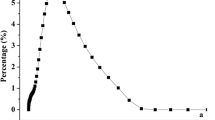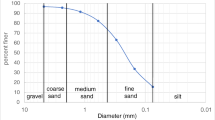Abstract
In the coal mines, the conducted activities are always associated with technical and natural hazards. One of the most dangerous sources of these hazards is the dispersed coal dust. Today, considering the successful application of bacteria in the engineering industries, the present study aimed at stabilizing and preventing coal dust entering the air using biological agents. Therefore, the effect of spraying Bacillus subtilis bacteria, as a calcium carbonate precipitator microorganism, on the surface of coal dust was evaluated. Accordingly, the certain volume of bacteria was sprayed on coal dust samples and their resistance against the wind was compared in two different speeds. The results showed the reduction of entering the coal dust into the air and this trend had considerable progress during 14 days. Spraying the bacteria improved the dust stabilization by 87% compared to control sample (dry coal dust) and the rising coal dust from the surface was about 40% less than the conventional methods. Besides, increasing the volume of bacteria led to faster forming and more durable calcium carbonate layer. In addition, X-ray diffraction (XRD) and urease test confirmed the formation of calcium carbonate layer on the sample surface.










Similar content being viewed by others
References
Aneja K (2003) Experiments in microbiology, plant pathology and biotechnology. New Age International, New Delhi
Bazzanella A, Becker H, Kemper F (1986) Dust suppression in shearer faces. Gluckauf Transl 122(11):204–207
Borm PJ (1997) Toxicity and occupational health hazards of coal fly ash (CFA). A review of data and comparison to coal mine dust. Ann Occup Hyg 41:659–676
Cain P (2003) The use of stone dust to control coal dust explosions: a review of international practice. ROKDOK. Prepared for Underground Coal Mining safety Research Collaboration (an association of stakeholders in the Canadian underground coal mining industry). http://www.ugcoal.ca. Accessed 15 Mar 2003
Cashdollar KL, Green GM, Harteis SP, Man C-K, Sapko M, Weiss ES (2010) Recommendations for a new rock dusting standard to prevent coal dust explosions in intake airways. Pittsburgh, PA: US Department of Health and Human Services. Public Health Service, Centers for Disease Control and Prevention, National Institute for Occupational Safety and Health, DHHS (NIOSH) Publication no. 2010-151, Report of Investigations 9679, 49
Chaturvedi S, Chandra R, Rai V (2006) Isolation and characterization of Phragmites australis (L.) rhizosphere bacteria from contaminated site for bioremediation of colored distillery effluent. Ecol Eng 27:202–207. https://doi.org/10.1016/j.ecoleng.2006.02.008
Cheng L, Cord-Ruwisch R (2012) In situ soil cementation with ureolytic bacteria by surface percolation. Ecol Eng 42:64–72
Cybulski W (1975) Coal dust explosions and their suppression. Bureau of Mines, U.S. Department of the Interior and the National Science Foundation, Washington, D.C.
Cybulski K, Malich B, Wieczorek A (2015) Evaluation of the effectiveness of coal and mine dust wetting. J Sustain Min 14:83–92
de Boer Sietske A, Diderichsen B (1991) On the safety of Bacillus subtilis and B. amyloliquefaciens: a review. Appl Microbiol Biotechnol 36:1–4. https://doi.org/10.1007/bf00164689
De Muynck W, Debrouwer D, De Belie N, Verstraete W (2008) Bacterial carbonate precipitation improves the durability of cementitious materials. Cem Concr Res 38:1005–1014. https://doi.org/10.1016/j.cemconres.2008.03.005
Dick J, De Windt W, De Graef B, Saveyn H, Van der Meeren P, De Belie N, Verstraete W (2006) Bio-deposition of a calcium carbonate layer on degraded limestone by Bacillus species. Biodegradation 17:357–367. https://doi.org/10.1007/s10532-005-9006-x
Finkelman RB et al (2002) Health impacts of coal and coal use: possible solutions. Int J Coal Geol 50:425–443
Ghosh P, Mandal S, Chattopadhyay B, Pal S (2005) Use of microorganism to improve the strength of cement mortar. Cem Concr Res 35:1980–1983
Gross A, Kaplan D, Baker K (2007) Removal of chemical and microbiological contaminants from domestic greywater using a recycled vertical flow bioreactor (RVFB). Ecol Eng 31:107–114
Hamilton R, Knight G (1957) Laboratory experiments on dust suppression with broken coal (no. 2083, pp 4–6). Report
Hammad I, Talkhan F, Zoheir A (2013) Urease activity and induction of calcium carbonate precipitation by Sporosarcina pasteurii NCIMB 8841. J Appl Sci Res 9:1525–1533
Jugnia L-B, Cabral AR, Greer CW (2008) Biotic methane oxidation within an instrumented experimental landfill cover. Ecol Eng 33:102–109
Kalhori H, Bagherpour R (2017) Application of carbonate precipitating bacteria for improving properties and repairing cracks of shotcrete. Constr Build Mater 148:249–260
Kurnia JC, Sasmito AP, Mujumdar AS (2014) Dust dispersion and management in underground mining faces. Int J Min Sci Technol 24:39–44
Le Metayer-Levrel G, Castanier S, Orial G, Loubiere J-F, Perthuisot J-P (1999) Applications of bacterial carbonatogenesis to the protection and regeneration of limestones in buildings and historic patrimony. Sediment Geol 126(1–4):25–34
Meyer F, Bang S, Min S, Stetler L, Bang S (2011) Microbiologically-induced soil stabilization: application of Sporosarcina pasteurii for fugitive dust control. In: Geo-frontiers 2011: advances in geotechnical engineering. Geotechnical Special Publications, Dallas, Texas, pp 4002–4011. https://doi.org/10.1061/41165(397)409
Pengfei W, Tao F, Ronghua L (2011) Numerical simulation of dust distribution at a fully mechanized face under the isolation effect of an air curtain. Min Sci Technol (China) 21:65–69
Petsonk EL, Rose C, Cohen R (2013) Coal mine dust lung disease. New lessons from an old exposure. Am J Respir Crit Care Med 187:1178–1185
Pollock D, Organiscak J (2007) Airborne dust capture and induced airflow of various spray nozzle designs. Aerosol Sci Technol 41:711–720
Prostański D (2013) Use of air-and-water spraying systems for improving dust control in mines. J Sustain Min 12:29–34
Reddy S, Rao M, Aparna P, Sasikala C (2010) Performance of standard grade bacterial (Bacillus subtilis) concrete. Asian J Civ Eng (Build Hous) 11:43–55
Ren W, Wang D, Guo Q, Zuo B (2014) Application of foam technology for dust control in underground coal mine. Int J Min Sci Technol 24:13–16. https://doi.org/10.1016/j.ijmst.2013.12.003
Ren W, Shi J, Guo Q, Zhao Q, Bai L (2017) The influence of dust particles on the stability of foam used as dust control in underground coal mines. Process Saf Environ Prot 111:740–746
Richmond JK, Liebman I, Miller LF (1975) Effect of rock dust on explosibility of coal dust. US Dept. of the Interior, Bureau of Mines, Washington, D.C.
Ross M, Murray J (2004) Occupational respiratory disease in mining. Occup Med 54:304–310
Rushing JF, Harrison A, Tingle JS, Mason Q, McCaffrey T (2006) Evaluation of dust palliatives for unpaved roads in arid climates. J Perform Constr Facil 20:281–286
Sapko MJ, Cashdollar KL, Green GM (2007) Coal dust particle size survey of US mines. J Loss Prev Process Ind 20:616–620
Toraño J, Torno S, Menéndez M, Gent M (2011) Auxiliary ventilation in mining roadways driven with roadheaders: validated CFD modelling of dust behaviour. Tunn Undergr Space Technol 26:201–210
Wang Q, Wang D, Wang H, Han F, Zhu X, Tang Y, Si W (2015) Optimization and implementation of a foam system to suppress dust in coal mine excavation face. Process Saf Environ Prot 96:184–190. https://doi.org/10.1016/j.psep.2015.05.009
Wei N, Zhongan J, Dongmei T (2011) Numerical simulation of the factors influencing dust in drilling tunnels: its application. Min Sci Technol (China) 21:11–15
Zheng Y-P, Feng C-G, Jing G-X, Qian X-M, Li X-J, Liu Z-Y, Huang P (2009) A statistical analysis of coal mine accidents caused by coal dust explosions in China. J Loss Prev Process Ind 22:528–532
Author information
Authors and Affiliations
Corresponding author
Additional information
Publisher’s Note
Springer Nature remains neutral with regard to jurisdictional claims in published maps and institutional affiliations.
Rights and permissions
About this article
Cite this article
Farashahi, M., Bagherpour, R., Kalhori, H. et al. Application of bacteria for coal dust stabilization. Environ Earth Sci 78, 178 (2019). https://doi.org/10.1007/s12665-019-8194-3
Received:
Accepted:
Published:
DOI: https://doi.org/10.1007/s12665-019-8194-3




